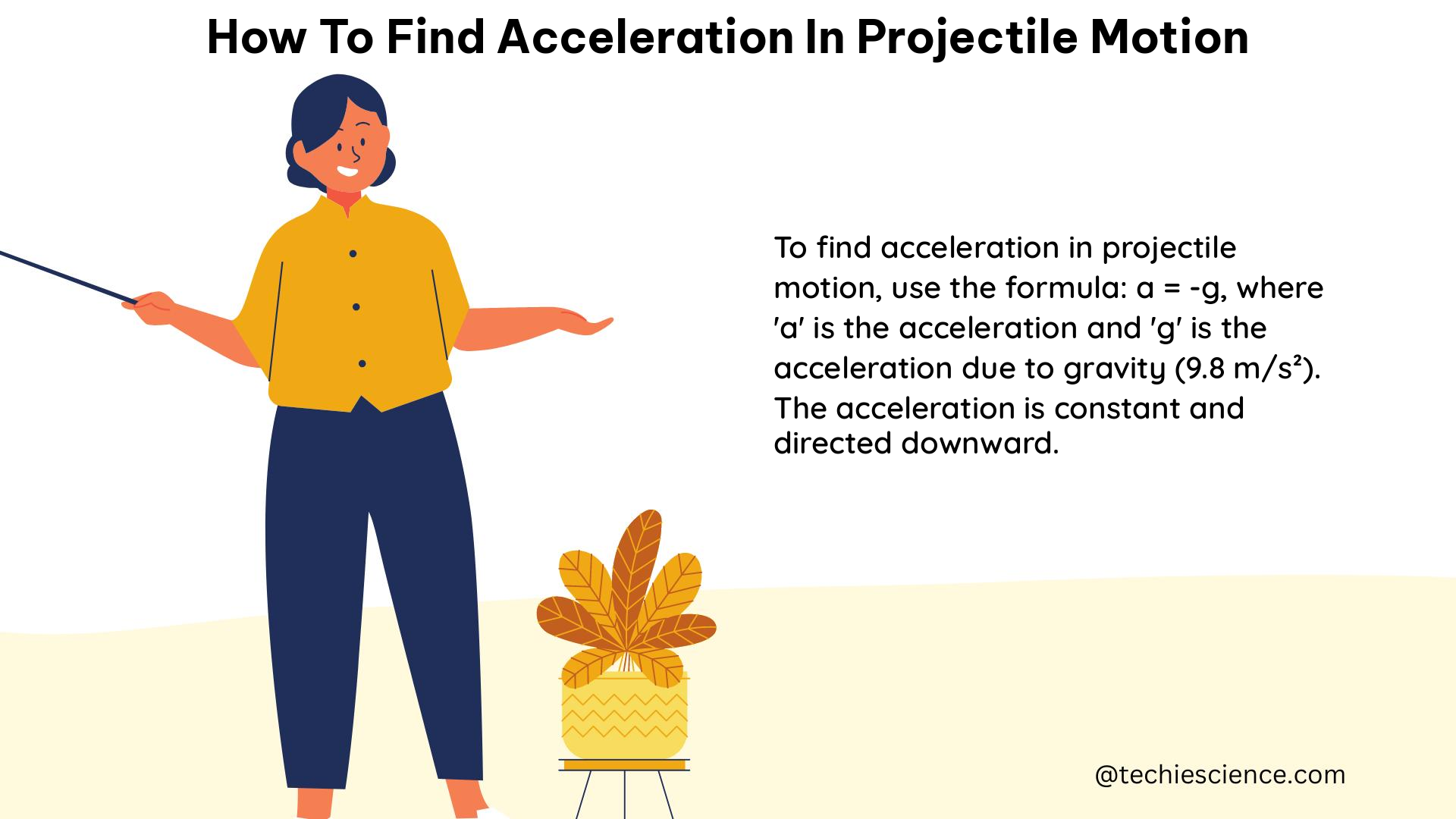Projectile motion is a fundamental concept in physics, and understanding the acceleration involved is crucial for analyzing the trajectory and behavior of moving objects. This comprehensive guide will delve into the details of finding acceleration in projectile motion, providing you with the necessary tools and techniques to master this topic.
Understanding Acceleration in Projectile Motion
In projectile motion, the acceleration experienced by the object is primarily due to the force of gravity, which acts vertically downward. This acceleration, denoted as ‘g’, is approximately equal to 9.8 m/s² on Earth’s surface. The key to finding the acceleration in projectile motion is to recognize that the motion can be broken down into two independent components: the horizontal component and the vertical component.
Horizontal Component
The horizontal component of the motion has no acceleration. The object’s horizontal velocity remains constant throughout the trajectory, as long as there are no other external forces acting on it.
Vertical Component
The vertical component of the motion experiences a constant acceleration due to gravity, acting downward. This acceleration is the same for all objects, regardless of their mass or other properties.
Equations for Projectile Motion

To find the acceleration in projectile motion, we can utilize various equations that describe the motion. Here are some of the most commonly used equations:
Time of Flight
The time of flight, denoted as ‘t’, is the total time the projectile is in the air. It can be calculated using the equation:
t = √(2h/g)
Where:
– h is the initial height of the projectile
– g is the acceleration due to gravity (9.8 m/s²)
Range
The range, denoted as ‘R’, is the horizontal distance traveled by the projectile. It can be calculated using the equation:
R = ux * t = ux * √(2h/g)
Where:
– ux is the initial horizontal velocity of the projectile
– t is the time of flight
Projectile Launched at an Angle
For a projectile launched at an angle θ with an initial velocity vo, the range can be calculated using the equation:
R = (vo² * sin(2θ))/g
Where:
– vo is the initial velocity of the projectile
– θ is the launch angle
– g is the acceleration due to gravity (9.8 m/s²)
Examples and Numerical Problems
Let’s explore some examples and numerical problems to better understand how to find the acceleration in projectile motion.
Example 1: Projectile Launched Horizontally
Suppose a projectile is launched horizontally from a height of 50 meters. Calculate the time of flight and the range of the projectile.
Given:
– Initial height, h = 50 m
– Acceleration due to gravity, g = 9.8 m/s²
Step 1: Calculate the time of flight
t = √(2h/g)
t = √(2 * 50 / 9.8)
t = 3.2 seconds
Step 2: Calculate the range
R = ux * t
R = ux * √(2h/g)
Since the projectile is launched horizontally, the initial horizontal velocity ux is equal to the total initial velocity vo. Let’s assume vo = 20 m/s.
R = 20 * √(2 * 50 / 9.8)
R = 40 meters
Example 2: Projectile Launched at an Angle
A projectile is launched with an initial velocity of 50 m/s at an angle of 30 degrees above the horizontal. Calculate the range of the projectile.
Given:
– Initial velocity, vo = 50 m/s
– Launch angle, θ = 30 degrees
– Acceleration due to gravity, g = 9.8 m/s²
Step 1: Convert the angle from degrees to radians
θ (radians) = θ (degrees) * π/180
θ (radians) = 30 * π/180 = π/6
Step 2: Calculate the range
R = (vo² * sin(2θ))/g
R = (50² * sin(2 * π/6))/9.8
R = 62.5 meters
Additional Considerations
-
Projectile Motion in 3D: While the examples provided focus on 2D projectile motion, the principles can be extended to 3D scenarios by considering the motion in the x, y, and z directions.
-
Air Resistance: In real-world situations, air resistance can have a significant impact on the projectile’s motion. To account for air resistance, more advanced equations and numerical simulations may be required.
-
Projectile Motion in Sports: Projectile motion is widely observed in various sports, such as basketball, baseball, golf, and archery. Understanding the acceleration involved can help athletes and coaches optimize their techniques and strategies.
-
Numerical Simulations: Computer simulations can be a powerful tool for visualizing and analyzing projectile motion, allowing for the exploration of more complex scenarios and the investigation of the effects of different parameters.
Conclusion
Mastering the concept of finding acceleration in projectile motion is a crucial step in understanding the fundamental principles of physics. By applying the equations and techniques presented in this guide, you can confidently analyze the motion of projectiles, predict their trajectories, and solve a wide range of physics problems. Remember to practice regularly and explore more advanced topics to deepen your understanding of this fascinating field of study.
Reference:

The lambdageeks.com Core SME Team is a group of experienced subject matter experts from diverse scientific and technical fields including Physics, Chemistry, Technology,Electronics & Electrical Engineering, Automotive, Mechanical Engineering. Our team collaborates to create high-quality, well-researched articles on a wide range of science and technology topics for the lambdageeks.com website.
All Our Senior SME are having more than 7 Years of experience in the respective fields . They are either Working Industry Professionals or assocaited With different Universities. Refer Our Authors Page to get to know About our Core SMEs.